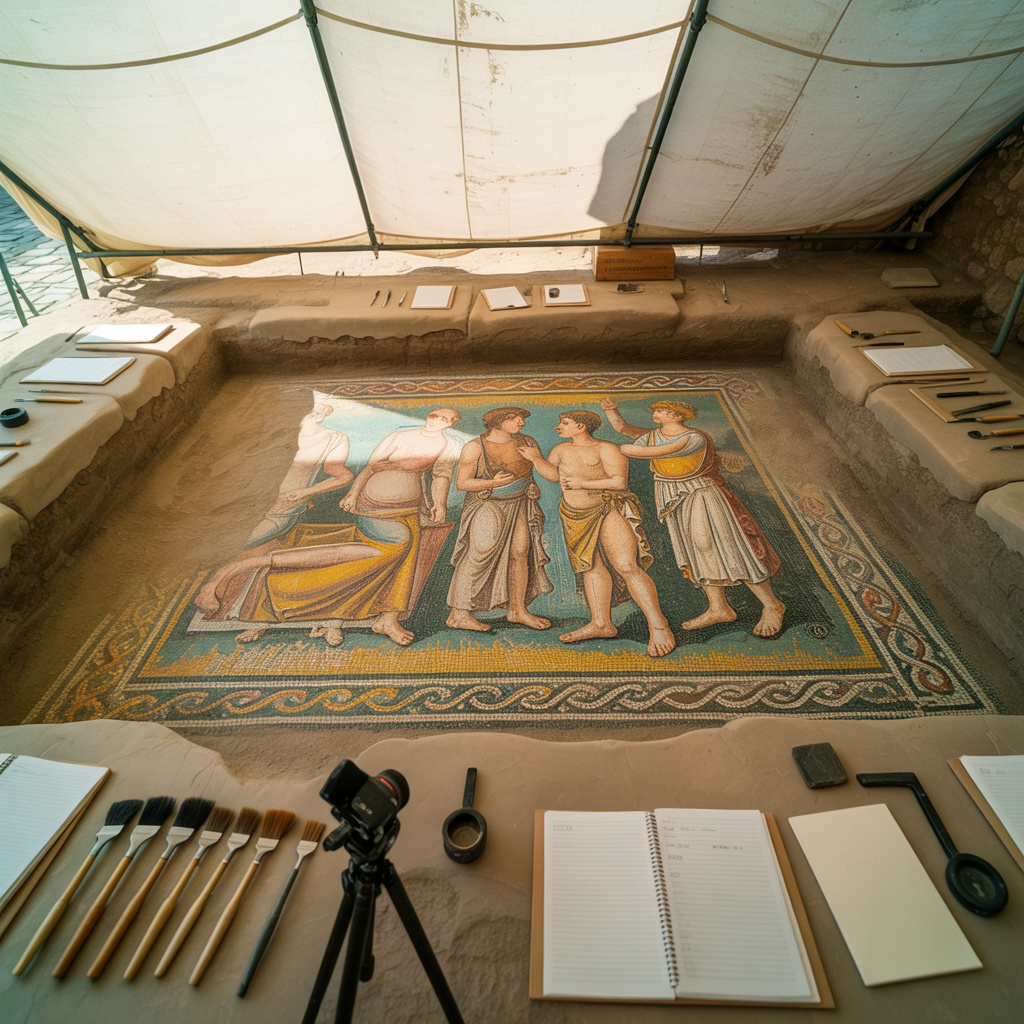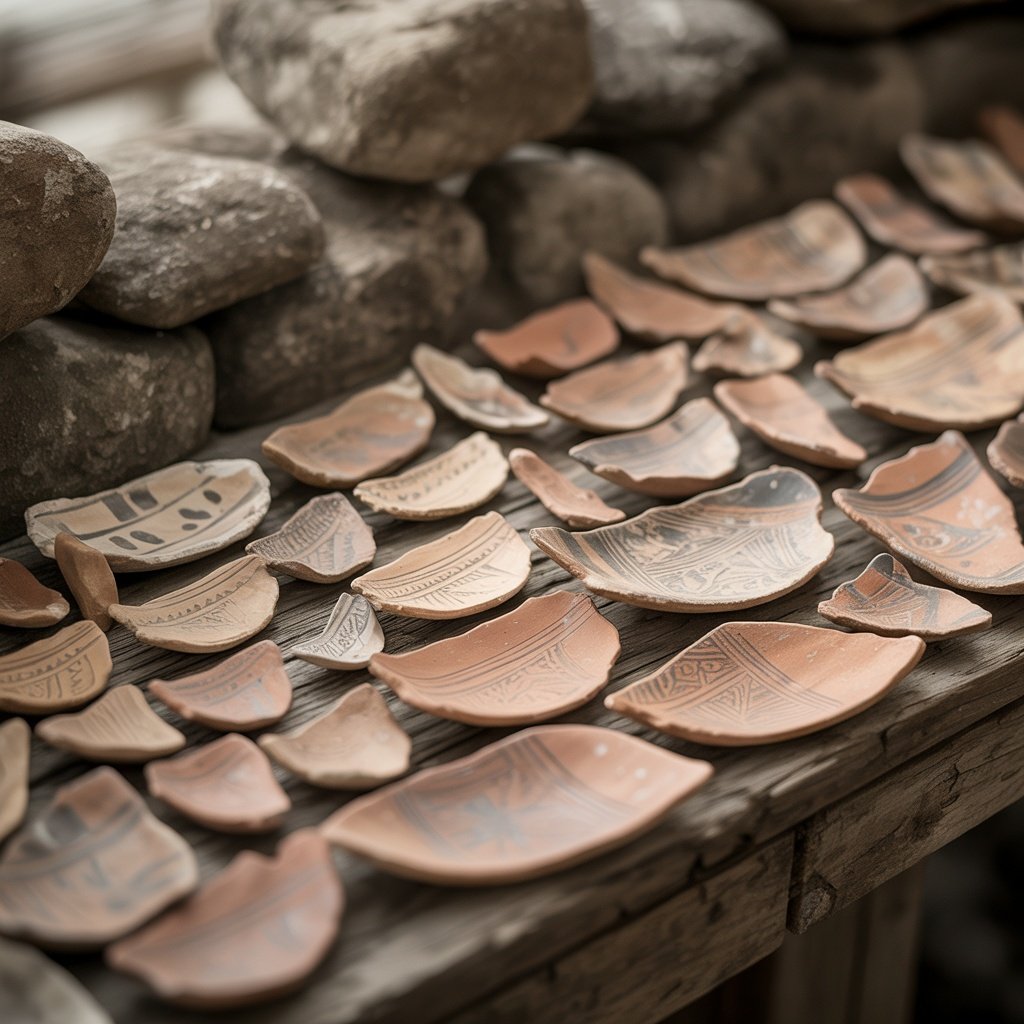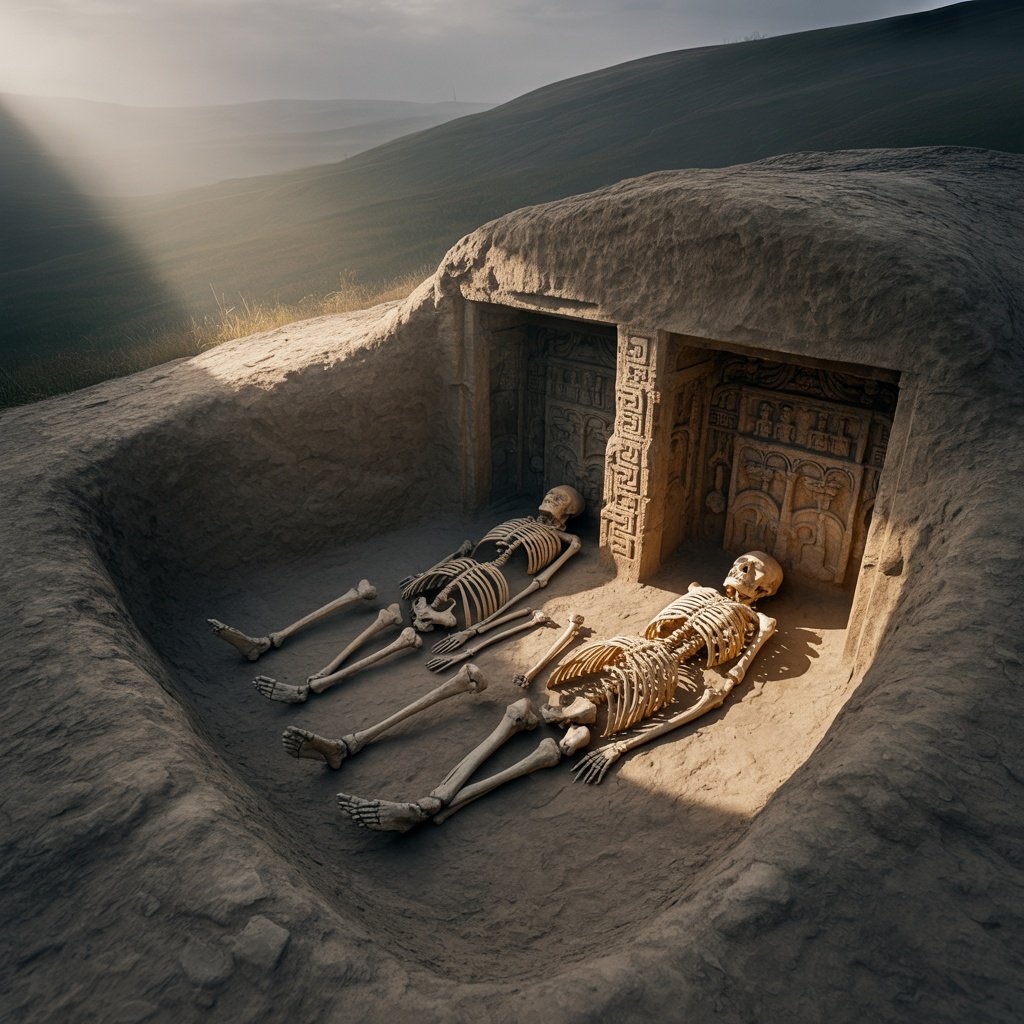Throughout the 19th and early 20th centuries, newspaper accounts and archaeological reports from across eastern North America documented discoveries of unusually tall skeletal remains within ancient burial mounds. One particularly striking claim involved the alleged discovery of 49 skeletons of "giant" proportions in Ohio, part of a broader pattern of reports that have fuelled both legitimate archaeological inquiry and unfounded speculation about the continent's prehistoric inhabitants.
As specialists in archaeological heritage research, we approach these historical claims with rigorous methodology, examining primary sources, understanding the cultural context of 19th-century archaeology, and distinguishing between verified evidence and sensationalised reporting. This comprehensive analysis explores what we actually know about mound builder cultures, the evidence for unusual skeletal remains, and why this topic continues generating controversy.
The Mound Builder Cultures of North America
The term "Mound Builders" encompasses several distinct prehistoric cultures that constructed earthen mounds across eastern North America from approximately 3500 BCE through the 16th century CE. These cultures include the Adena (circa 1000-200 BCE), Hopewell (circa 200 BCE-500 CE), and Mississippian (circa 800-1600 CE) traditions, among others.
These sophisticated societies built thousands of mounds serving various functions: burial monuments, ceremonial platforms, effigy structures representing animals or cosmological symbols, and foundations for important buildings. The largest and most complex mound sites—including Cahokia near modern St. Louis, Poverty Point in Louisiana, and Newark Earthworks in Ohio—required coordinated labour from substantial populations and demonstrated advanced understanding of geometry, astronomy, and engineering.
19th Century Discovery Context
When European-American settlers expanded westward across the Ohio Valley and Mississippi River watershed in the late 18th and early 19th centuries, they encountered thousands of ancient earthen mounds. Unable to credit Native Americans with such sophisticated constructions, many settlers and scholars proposed alternative theories attributing the mounds to lost civilisations of Europeans, ancient Israelites, or other non-indigenous peoples.
This cultural context influenced how skeletal discoveries were interpreted and reported. Finds that deviated from expected patterns—including unusually tall individuals—were sometimes sensationalised to support theories about exotic mound builder origins. Newspaper editors, seeking sensational content to attract readers, often exaggerated or fabricated details about archaeological discoveries.
Examining the Historical Claims

The specific claim about 49 giant skeletons appears in various 19th-century newspaper accounts, typically attributed to discoveries in Ohio burial mounds. These reports generally describe skeletons measuring between seven and nine feet tall, sometimes accompanied by unusual artefacts or architectural features within the burial chambers.
Primary Source Analysis
Careful examination of original newspaper accounts reveals several problematic patterns. Most reports lack specific details about exact locations, excavator names, or institutional affiliations that would allow verification. Measurements are often imprecise or clearly exaggerated. The reports frequently appear in multiple newspapers with suspiciously similar wording, suggesting copying rather than independent verification.
Some accounts can be traced to specific individuals who later proved unreliable or whose claims were debunked by contemporary archaeologists. For example, the physician and archaeologist Joseph Jones investigated many such claims in the 1870s and found most to be based on faulty measurements, misidentifications, or deliberate hoaxes.
The Question of Measurement Standards
Understanding 19th-century measurement practices is crucial for evaluating skeletal height claims. Excavators often measured from the top of the skull to the bottom of the burial rather than articulated skeletal height. Burials in which bodies had been placed in unusual positions, or where disarticulated remains from multiple individuals occupied the same grave, could easily produce misleading measurements.
Additionally, skeletal remains often include ceremonial adornment such as copper headpieces or elaborate headdresses that, if included in measurements, would add substantial "height" to the deceased. Some reports describing "giant" skeletons likely measured total burial length including such adornments rather than actual skeletal height.
What Modern Archaeology Reveals
Contemporary archaeological investigation using rigorous scientific methods has examined thousands of skeletal remains from mound builder cultures. This research provides clear evidence about the physical characteristics of these ancient populations:
Height Distributions in Ancient Populations
Systematic bioarchaeological studies demonstrate that mound builder populations had average heights comparable to other pre-industrial agricultural societies. Adult males typically stood between 165-175 centimetres (5'5" to 5'9"), whilst females averaged 155-165 centimetres (5'1" to 5'5"). These averages fall within normal human variation and show no evidence of unusual height.
However, like all human populations, mound builder societies included individuals at the statistical extremes. Individuals reaching 185-190 centimetres (6'1" to 6'3") would have been uncommon but not impossible. Such individuals might have been noted as unusually tall within their communities and perhaps given special burial treatment—which could explain why some excavated burials appeared to contain exceptionally large individuals.
The Role of Pathological Conditions
Modern skeletal analysis reveals that some individuals in ancient populations suffered from pathological conditions affecting growth. Pituitary gigantism and acromegaly—conditions caused by growth hormone excess—can produce individuals of exceptional height. Archaeological evidence confirms that such conditions occurred in prehistoric populations, though rarely.
These medically exceptional individuals might indeed have reached heights of 200-210 centimetres (6'7" to 6'11")—unusually tall but within known human variation rather than evidence of a distinct "giant race." If such individuals received special burial treatment, they might be overrepresented in archaeological discovery records relative to their actual population frequency.
The Archaeological Evidence That Does Exist

Whilst extraordinary claims about giant skeletons lack supporting evidence, legitimate archaeological research has documented genuine mysteries and remarkable achievements of mound builder cultures:
Sophisticated Astronomical Knowledge
Many mound complexes demonstrate precise astronomical alignments. The Newark Earthworks in Ohio, for instance, align with the lunar standstill cycle—a complex astronomical phenomenon with an 18.6-year period. The Cahokia site includes a "woodhenge" that marked solstices and equinoxes. These alignments required sustained observation and sophisticated mathematical knowledge.
Long-Distance Trade Networks
Artefacts recovered from mound sites reveal extensive trade networks spanning the continent. Copper from Lake Superior, shells from the Gulf Coast, obsidian from the Rocky Mountains, and mica from Appalachia all appear in Hopewell burial mounds, indicating that these societies maintained contact across vast distances centuries before European contact.
Complex Social Organisation
The labour requirements for major mound construction indicate complex social organisation capable of coordinating large workforces. Cahokia at its peak (circa 1050-1200 CE) may have housed 10,000-20,000 people, with influence extending across much of eastern North America. This urban complexity rivalled or exceeded contemporary European cities.
Why the "Giant" Claims Persist
Despite lack of credible evidence, claims about giant skeletons continue circulating, particularly in fringe archaeology literature and online forums. Several factors explain this persistence:
Incomplete Public Awareness of Archaeological Evidence
Most people lack access to professional archaeological literature and rely on popular media for information about the past. Sensational claims about giants prove more memorable and shareable than nuanced discussions of prehistoric demographics and bioarchaeology, allowing misinformation to spread more effectively than accurate information.
Cultural Narratives and Identity Politics
Some groups promote giant skeleton claims to support particular worldviews about human history, often tied to religious interpretations or conspiracy theories about academic suppression of evidence. These narratives persist because they serve psychological and social functions beyond truth-seeking—they provide communities with distinctive belief systems and identity markers.
Genuine Archaeological Mysteries
The actual archaeological record of mound builder cultures does contain legitimate mysteries: the purposes of certain structures, the meanings of complex iconography, the reasons for site abandonments, and the detailed workings of their societies. This real uncertainty creates space where speculative theories can flourish, with some individuals extending from genuine unknowns to unsupported claims.
Visiting Authentic Mound Builder Sites

Rather than pursuing dubious claims about giants, interested visitors can explore authentic mound builder sites that reveal the genuine achievements of these sophisticated cultures:
Cahokia Mounds State Historic Site, Illinois
The largest pre-Columbian settlement north of Mexico, Cahokia features over 80 mounds including Monks Mound, the largest earthen structure in the Americas. The site's excellent interpretive centre explains current archaeological understanding of this remarkable urban centre that flourished from approximately 1050-1350 CE.
Poverty Point World Heritage Site, Louisiana
Dating to approximately 1650-700 BCE, Poverty Point demonstrates sophisticated engineering and social organisation from the Late Archaic period. The site's massive concentric earthen ridges and mounds required millions of hours of labour, revealing complex society existing far earlier than once believed possible in North America.
Serpent Mound, Ohio
This iconic effigy mound stretches over 400 metres in a serpentine form, demonstrating the artistic and engineering capabilities of its builders. Recent research has clarified the site's age and cultural attribution, whilst its astronomical alignments continue generating research interest.
Moundville Archaeological Park, Alabama
This Mississippian culture site features 29 major mounds arranged around a central plaza. The site museum displays artefacts and explains the sophisticated culture that created this ceremonial and political centre between approximately 1000-1450 CE.
Our archaeological expedition services arrange guided tours of these and other mound builder sites, providing expert interpretation that distinguishes verified archaeological evidence from speculative claims whilst revealing the genuine sophistication of these ancient North American cultures.
The Importance of Rigorous Archaeology
The controversy surrounding giant skeleton claims illustrates why rigorous archaeological methodology matters. Professional archaeology employs systematic excavation techniques, detailed documentation, peer review, and skeptical evaluation of extraordinary claims. This approach may seem pedantic compared to sensational narratives, but it provides the most reliable path to understanding the past.
Modern Bioarchaeology Methods
Contemporary skeletal analysis employs sophisticated techniques unavailable to 19th-century excavators. Osteometric measurements follow standardised protocols allowing accurate height reconstruction. Isotopic analysis reveals diet and migration patterns. Ancient DNA analysis illuminates population relationships and individual ancestry. Palaeopathology identifies diseases and injuries affecting ancient populations.
These methods have revealed fascinating insights about mound builder populations: their diets shifted as agriculture intensified, some communities experienced violence whilst others lived peacefully, social hierarchies became more pronounced in later periods, and populations were more genetically continuous with modern Native Americans than early scholars assumed.
Ethical Considerations and Indigenous Perspectives
Modern archaeology recognises that mound builder sites and remains connect to living descendant communities. The Native American Graves Protection and Repatriation Act (NAGPRA) mandates consultation with tribes regarding cultural items and human remains, acknowledging that archaeological materials belong to cultural communities rather than being ownerless resources for scientific study.
Many Native American communities find "giant race" theories offensive because they deny indigenous peoples' ancestral connections to archaeological sites and perpetuate harmful narratives that ancient achievements required non-Native origins. Responsible archaeological tourism respects these perspectives and promotes accurate understanding of indigenous history and heritage.
Critical Thinking and Evaluating Sources
The giant skeleton controversy provides valuable lessons in evaluating historical claims and distinguishing reliable from unreliable sources:
- Primary sources should be evaluated for contemporary context, author credibility, and potential biases
- Extraordinary claims require extraordinary evidence, particularly when contradicting established knowledge
- Multiple independent confirmations strengthen claims more than repetition of single sources
- Professional archaeological literature undergoes peer review that filters claims based on methodological rigor
- Physical evidence preserved in museum collections allows verification, whilst claims lacking preserved specimens remain suspect
Applying these principles to giant skeleton claims reveals their weakness: they rely primarily on unverifiable 19th-century newspaper accounts, lack physical evidence in museum collections despite supposedly numerous discoveries, contradict systematic bioarchaeological research, and depend on special pleading about evidence suppression to explain absence of confirmation.
